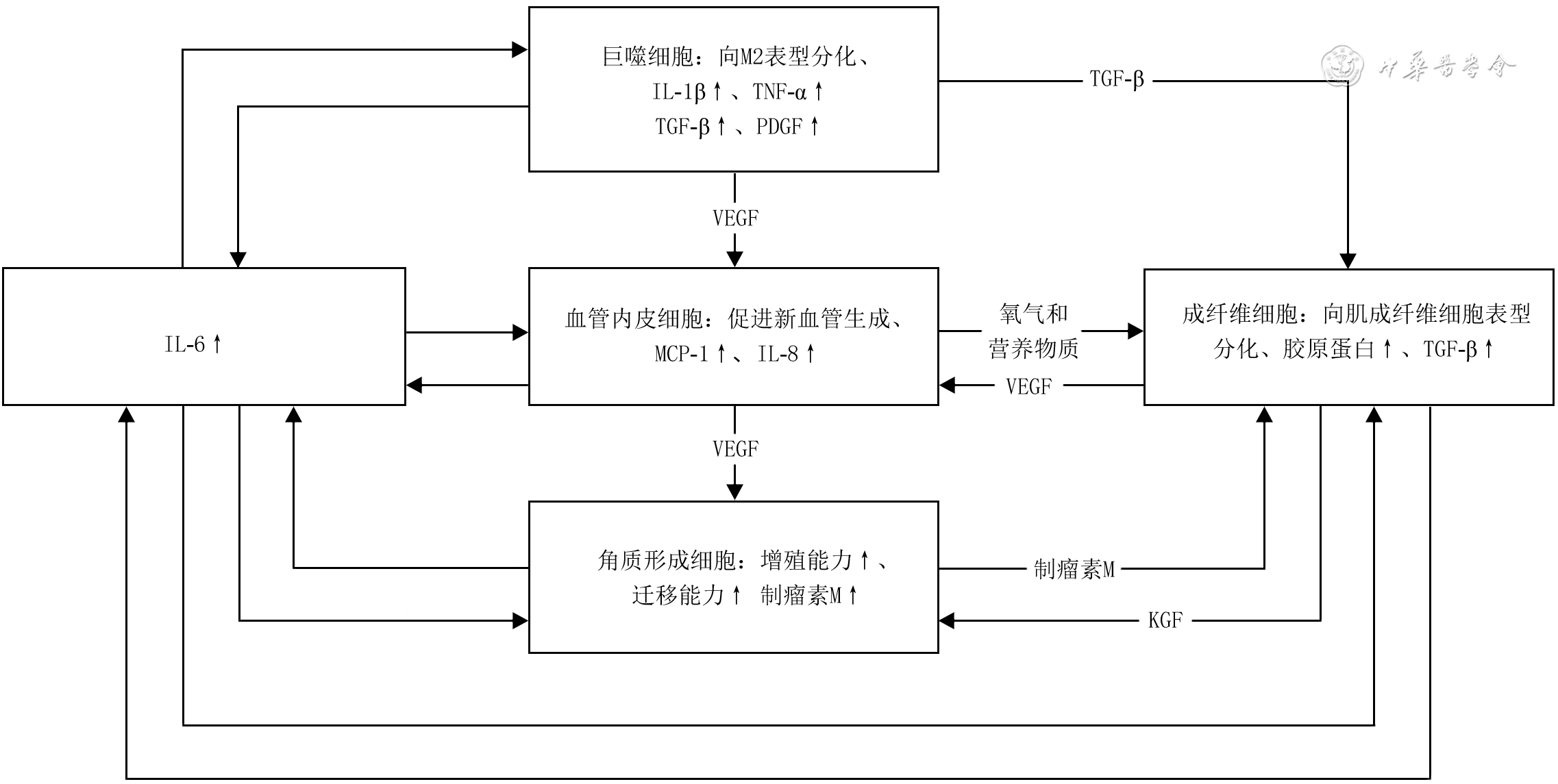| [1] |
岑瑛, 刘睿奇. 瘢痕的研究新进展及临床治疗[J].中华烧伤杂志,2019,35(12):839-841. DOI: 10.3760/cma.j.issn.1009-2587.2019.12.002.
|
| [2] |
WilgusTA. Inflammation as an orchestrator of cutaneous scar formation: a review of the literature[J]. Plast Aesthet Res, 2020,7:54.DOI: 10.20517/2347-9264.2020.150.
|
| [3] |
TanJ, WuJ. Current progress in understanding the molecular pathogenesis of burn scar contracture[J/OL]. Burns Trauma, 2017,5:14[2022-04-12]. https://pubmed.ncbi.nlm.nih.gov/28546987/.DOI: 10.1186/s41038-017-0080-1.
|
| [4] |
OgawaR, AkitaS, AkaishiS, et al. Diagnosis and treatment of keloids and hypertrophic scars-Japan Scar Workshop Consensus Document 2018[J/OL]. Burns Trauma, 2019,7:39[2022-04-12]. https://pubmed.ncbi.nlm.nih.gov/31890718/. DOI: 10.1186/s41038-019-0175-y.
|
| [5] |
ChippE, CharlesL, ThomasC, et al. A prospective study of time to healing and hypertrophic scarring in paediatric burns: every day counts[J/OL]. Burns Trauma, 2017,5:3[2022-04-12]. https://pubmed.ncbi.nlm.nih.gov/28116323/. DOI: 10.1186/s41038-016-0068-2.
|
| [6] |
van ZuijlenPP, RuurdaJJ, van VeenHA, et al. Collagen morphology in human skin and scar tissue: no adaptations in response to mechanical loading at joints[J]. Burns, 2003,29(5):423-431. DOI: 10.1016/s0305-4179(03)00052-4.
|
| [7] |
WongVW, PaternoJ, SorkinM, et al. Mechanical force prolongs acute inflammation via T-cell-dependent pathways during scar formation[J]. FASEB J, 2011,25(12):4498-4510. DOI: 10.1096/fj.10-178087.
|
| [8] |
ShiJ, ShiS, XieW, et al. IL-10 alleviates lipopolysaccharide- induced skin scarring via IL-10R/STAT3 axis regulating TLR4/NF-κB pathway in dermal fibroblasts[J]. J Cell Mol Med, 2021,25(3):1554-1567. DOI: 10.1111/jcmm.16250.
|
| [9] |
ShiJ, ShiS, XieW, et al. IL-10 alleviates lipopolysaccharide- induced skin scarring via IL-10R/STAT3 axis regulating TLR4/NF-κB pathway in dermal fibroblasts[J]. J Cell Mol Med, 2021, 25(3):1554-1567. DOI: 10.1111/jcmm.16250.
|
| [10] |
QianLW, FourcaudotAB, YamaneK, et al. Exacerbated and prolonged inflammation impairs wound healing and increases scarring[J]. Wound Repair Regen, 2016,24(1):26-34. DOI: 10.1111/wrr.12381.
|
| [11] |
DongX, MaoS, WenH. Upregulation of proinflammatory genes in skin lesions may be the cause of keloid formation (Review)[J]. Biomed Rep, 2013,1(6):833-836. DOI: 10.3892/br.2013.169.
|
| [12] |
BermanB, MaderalA, RaphaelB. Keloids and hypertrophic scars: pathophysiology, classification, and treatment[J]. Dermatol Surg, 2017,43 Suppl 1:S3-18. DOI: 10.1097/DSS.0000000000000819.
|
| [13] |
李丽, 王林. 正常皮肤与病理性瘢痕组织中HIF-1α和促炎细胞因子水平比较及两者相关性研究[J].中国美容医学,2019,28(4):71-73.
|
| [14] |
LiechtyKW, AdzickNS, CrombleholmeTM. Diminished interleukin 6 (IL-6) production during scarless human fetal wound repair[J]. Cytokine, 2000,12(6):671-676. DOI: 10.1006/cyto.1999.0598.
|
| [15] |
刘娜, 张川, 杨磊, 等. 白细胞介素-6单克隆抗体抑制机械张力诱发小鼠增生性瘢痕[J].中华实验外科杂志,2017,34(12):2090-2092. DOI: 10.3760/cma.j.issn.1001-9030.2017.12.024.
|
| [16] |
HuangJ, ChenJ, WoY, et al. CO2 fractional laser combined with 5-fluorouracil ethosomal gel treatment of hypertrophic scar macro-, microscopic, and molecular mechanism of action in a rabbit animal model[J]. Rejuvenation Res, 2021,24(2):131-138. DOI: 10.1089/rej.2019.2204.
|
| [17] |
MurakamiM, KamimuraD, HiranoT. Pleiotropy and specificity: insights from the interleukin 6 family of cytokines[J]. Immunity, 2019,50(4):812-831. DOI: 10.1016/j.immuni.2019.03.027.
|
| [18] |
NaseemS, HussainT, ManzoorS. Interleukin-6: a promising cytokine to support liver regeneration and adaptive immunity in liver pathologies[J]. Cytokine Growth Factor Rev, 2018,39:36-45. DOI: 10.1016/j.cytogfr.2018.01.002.
|
| [19] |
SchumacherN, Rose-JohnS. ADAM17 activity and IL-6 trans-signaling in inflammation and cancer[J]. Cancers (Basel), 2019, 11(11):1736.DOI: 10.3390/cancers11111736.
|
| [20] |
LokauJ, AgtheM, FlynnCM, et al. Proteolytic control of interleukin-11 and interleukin-6 biology[J]. Biochim Biophys Acta Mol Cell Res, 2017,1864(11 Pt B):2105-2117. DOI: 10.1016/j.bbamcr.2017.06.008.
|
| [21] |
KaurS, BansalY, KumarR, et al. A panoramic review of IL-6: structure, pathophysiological roles and inhibitors[J]. Bioorg Med Chem, 2020,28(5):115327. DOI: 10.1016/j.bmc.2020.115327.
|
| [22] |
ChenW, YuanH, CaoW, et al. Blocking interleukin-6 trans-signaling protects against renal fibrosis by suppressing STAT3 activation[J]. Theranostics, 2019,9(14):3980-3991. DOI: 10.7150/thno.32352.
|
| [23] |
Epstein ShochetG, BrookE, Bardenstein-WaldB, et al. TGF-β pathway activation by idiopathic pulmonary fibrosis (IPF) fibroblast derived soluble factors is mediated by IL-6 trans- signaling[J]. Respir Res, 2020,21(1):56. DOI: 10.1186/s12931-020-1319-0.
|
| [24] |
HeinkS, YogevN, GarbersC, et al. Trans-presentation of IL-6 by dendritic cells is required for the priming of pathogenic TH17 cells[J]. Nat Immunol, 2017,18(1):74-85. DOI: 10.1038/ni.3632.
|
| [25] |
JonesSA, JenkinsBJ. Recent insights into targeting the IL-6 cytokine family in inflammatory diseases and cancer[J]. Nat Rev Immunol, 2018,18(12):773-789. DOI: 10.1038/s41577-018-0066-7.
|
| [26] |
JohnsonBZ, StevensonAW, PrêleCM, et al. The role of IL-6 in skin fibrosis and cutaneous wound healing[J]. Biomedicines, 2020, 8(5):101.DOI: 10.3390/biomedicines8050101.
|
| [27] |
ČomaM, FröhlichováL, UrbanL, et al. Molecular changes underlying hypertrophic scarring following burns involve specific deregulations at all wound healing stages (inflammation, proliferation and maturation)[J]. Int J Mol Sci, 2021,22(2):897.DOI: 10.3390/ijms22020897.
|
| [28] |
HasegawaM, SatoS, IhnH, et al. Enhanced production of interleukin-6 (IL-6), oncostatin M and soluble IL-6 receptor by cultured peripheral blood mononuclear cells from patients with systemic sclerosis[J]. Rheumatology (Oxford), 1999,38(7):612-617. DOI: 10.1093/rheumatology/38.7.612.
|
| [29] |
RayS, JuX, SunH, et al. The IL-6 trans-signaling-STAT3 pathway mediates ECM and cellular proliferation in fibroblasts from hypertrophic scar[J]. J Invest Dermatol, 2013,133(5):1212-1220. DOI: 10.1038/jid.2012.499.
|
| [30] |
DufourAM, AlvarezM, RussoB, et al. Interleukin-6 and type-I collagen production by systemic sclerosis fibroblasts are differentially regulated by interleukin-17A in the presence of transforming growth factor-beta 1[J]. Front Immunol, 2018,9:1865. DOI: 10.3389/fimmu.2018.01865.
|
| [31] |
Shapouri-MoghaddamA, MohammadianS, VaziniH, et al. Macrophage plasticity, polarization, and function in health and disease[J]. J Cell Physiol, 2018,233(9):6425-6440. DOI: 10.1002/jcp.26429.
|
| [32] |
XuX, GuS, HuangX, et al. The role of macrophages in the formation of hypertrophic scars and keloids[J/OL]. Burns Trauma, 2020,8:tkaa006[2022-05-07]. https://pubmed.ncbi.nlm.nih.gov/32341919/.DOI: 10.1093/burnst/taa006.
|
| [33] |
BrauneJ, WeyerU, HobuschC, et al. IL-6 regulates M2 polarization and local proliferation of adipose tissue macrophages in obesity[J]. J Immunol, 2017,198(7):2927-2934. DOI: 10.4049/jimmunol.1600476.
|
| [34] |
WernerS, KriegT, SmolaH. Keratinocyte-fibroblast interactions in wound healing[J]. J Invest Dermatol, 2007,127(5):998-1008. DOI: 10.1038/sj.jid.5700786.
|
| [35] |
PengY, WuS, TangQ, et al. KGF-1 accelerates wound contraction through the TGF-β1/Smad signaling pathway in a double-paracrine manner[J]. J Biol Chem, 2019,294(21):8361-8370. DOI: 10.1074/jbc.RA118.006189.
|
| [36] |
ZhuM, YangM, YangQ, et al. Chronic hypoxia-induced microvessel proliferation and basal membrane degradation in the bone marrow of rats regulated through the IL-6/JAK2/STAT3/MMP-9 pathway[J]. Biomed Res Int, 2020,2020:9204708. DOI: 10.1155/2020/9204708.
|
| [37] |
LinZQ, KondoT, IshidaY, et al. Essential involvement of IL-6 in the skin wound-healing process as evidenced by delayed wound healing in IL-6-deficient mice[J]. J Leukoc Biol, 2003,73(6):713-721. DOI: 10.1189/jlb.0802397.
|








 下载:
下载:

